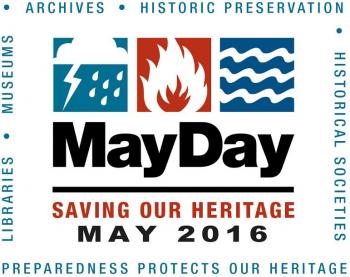 Riding in on the coattails of Preservation Week, MayDay is an annual tradition where libraries, museums, archives, historical societies, and preservation organizations set aside May 1 to participate in preparation activities for potential collections emergencies and disasters. First established by the Society of American Archivists and Heritage Preservation, and now taken on by the Foundation of the American Institute for Conservation, MayDay can be observed in several ways:
Riding in on the coattails of Preservation Week, MayDay is an annual tradition where libraries, museums, archives, historical societies, and preservation organizations set aside May 1 to participate in preparation activities for potential collections emergencies and disasters. First established by the Society of American Archivists and Heritage Preservation, and now taken on by the Foundation of the American Institute for Conservation, MayDay can be observed in several ways:
- Revisit your emergency preparedness plan. If you already have one in place, take time to reexamine elements that may have changed in the last year – contact information, emergency team roles, salvage priorities, etc. If you don’t have a plan quite yet, sit down and make a realistic timeline for its development.
- Participate in workshops and lectures covering emergency response and recovery. Having a written response plan is important, but understanding the hands-on salvage and recovery process can be invaluable if/when you find yourself in the situation. Sign up for local workshops to hone your skills, or, if you have the expertise, run your own workshop for local organizations!
- Inventory and replenish your emergency supplies. You may have used up some of your supplies over the last year for small emergencies or other collection activities. Take the time to inventory and replenish any supplies that may be missing from your kits.
- Don’t forget about the safety of your staff and volunteers! The safety of people always comes first. Lead a building evacuation and identify areas for improvement. Conduct a walkthrough of collection and office spaces and remove any potential hazards, such as boxes blocking a hallway, improper storage of chemicals (including cleaning supplies), and office ergonomics. Make sure that emergency exits, shelter-in-place locations, and evacuation routes are all clearly labeled.
The idea of creating an emergency preparedness and response plan, or simply revisiting an existing one, may be a bit daunting and tough to know where to start. Luckily, there are lots of resources out there that can help you in the initial planning phase. Here are a few key elements that I think are vital to include in, and tailor to, your unique plan.
- Clearly-defined staff roles – Each organization is unique not only in terms of their collections, but also in staff size and expertise. Identify who will be responsible for what during an emergency, and write it down in position descriptions. Here at SIA, the four roles we’ve identified for our emergency response team are: Emergency Coordinator, Assistant Emergency Coordinator, Emergency Recovery Coordinator, and Emergency Registrar.
- Salvage priorities – Get to know your collection well. Meet with other staff members and identify the highest priority collection materials based on factors such as: intellectual value, instability of materials, overall preservation concerns, use by researchers and scholars, and appraised value. Include dimensions and locations in your list to aid in the recovery process.
- Local emergency suppliers and contacts – When disaster strikes, you will need to know what companies are in your local geographic region that have the expertise to aid emergency activities such as moving collections, freezing and freeze-drying, mold remediation, digital data recovery, and dehumidification. Create and maintain a list of these vendors so that if you find yourself in the midst of a disaster, you know who to contact for help.
No matter how you choose to celebrate MayDay, just make sure you do ONE thing. Dust off those plans and make sure you’re ready! Additionally, if you report your fun and innovative emergency preparation activities to Gaylord Archival, you’ll be entered for a chance to win emergency supplies, including spill pillows, weatherproof paper, and a water detector.
Additional Resources for your consideration:
- The Getty Conservation Institute’s Building An Emergency Plan: A Guide for Museums and Other Cultural Institutions
- The American Alliance of Museum’s Alliance Reference Guide to Developing a Disaster Preparedness/Emergency Response Plan
- The International Council of Museums’ Guidelines for Disaster Preparedness in Museums
- The National Park Service’s Museum Handbook, Part 1, Chapter 10: Emergency Planning
Related Resources
Talking and Doing About Emergency Preparation, The Bigger Picture, Smithsonian Institution Archives
May Day Motto: Be Prepared, The Bigger Picture, Smithsonian Institution Archives
What to Do When More Than a Few Papers Get Wet, The Bigger Picture, Smithsonian Institution Archives
Produced by the Smithsonian Institution Archives. For copyright questions, please see the Terms of Use.

Leave a Comment